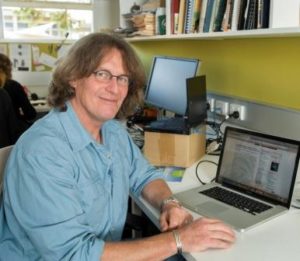
The hunt is on to find the rightful parents of a fossil egg that reputedly belongs to an extinct ancient bird from the Australian Ice Age.
French born, US-based fossil expert Dr Gerald Grellet has flown in from the States to work with Dr Trevor Worthy and Associate Professor Gavin Prideaux in Flinders University’s Palaeontology Department on a two-month mission to identify the true owner of a fossilised egg and remnant shells housed at the South Australian Museum.
The single egg and numerous shell fragments were unearthed from a site near Port Augusta in the 1980s, adding to a vast collection of fragments from across Australia which have all been linked to the Genyornis – a giant flightless bird much larger than an ostrich that lived in Australia until the mass extinction of megafauna in the Ice Age, some 50-40,000 years ago.
Dr Grellet, who works with research institutions globally on fossil and oological discoveries, says the Flinders team has serious doubts about the authenticity of the claim given the size of the so-called Genyornis egg is comparatively smaller than eggs produced by other large birds.
“According to several scientific journals, the egg and egg fragments belonged to the Genyornis, largely because this was the other giant bird known to live alongside emus,” Dr Grellet, an associate researcher at the Argentinean National Scientific and Technical Research Council and at the Field Museum in Chicago, said.
“The Genyornis was at least twice the size of an emu and perhaps six times the weight but the egg that’s been given to the Genyornis is actually shorter by one centimetre than the average emu egg and about a centimetre bigger in diameter so all in all it’s probably smaller than, or equal to, an emu egg,” he said.
“You couldn’t imagine a hummingbird laying an emu-sized egg so keeping that in mind, how could a bird that’s twice as big as an emu lay an egg the size of an emu egg or thereabouts?
“It raises serious questions as to why the egg materials are associated with the Genyornis when they’re not proportionate to the size of the bird.”
During Dr Grellet’s time at Flinders, the team will undertake oological assessments to determine factors including; the geology of the location where the eggs were found, the shape, dimension and thickness of the shell as well as the size and volume of the egg compared to the size and weight of the bird.
He will also conduct a series of phylogenetic tests to look for common characteristics between the egg matter and eggs from other birds that have a similar skeletal structure to the Genyornis, including the location and shape of their nests.
“There are other birds that became extinct at the same time that could very well be the owner of these egg materials, it’s just a case of knowing who’s who.”
If the eggs materials are found to belong to another bird, Dr Grellet said the history of Australia’s Ice Age would need to be rewritten: “The Genyornis egg has been one of the iconic fossils used as a tool to explain the controversial extinction of megafauna in Australia, and what caused it.
“So in changing the identity of the owner, how much will it change the story of what’s been written?
“It’s therefore my mission to help Dr Worthy and Associate Professor Prideaux make sense of this story and see where we stand in relation to the Genyornis bird and the very loosely associated oology of the egg and egg matter.”

